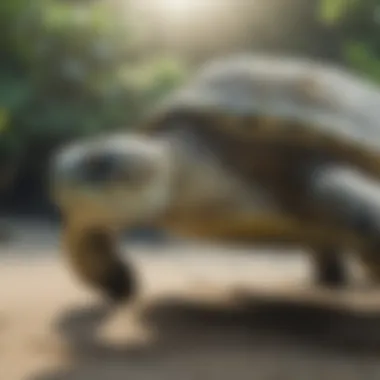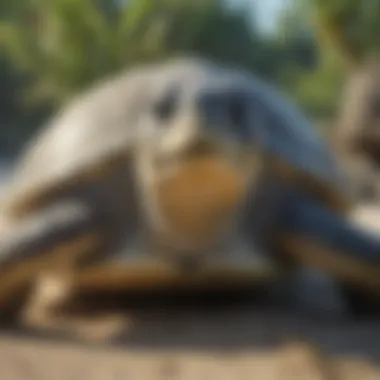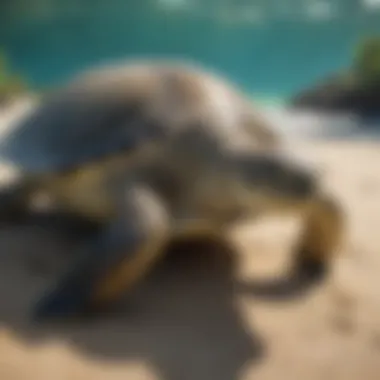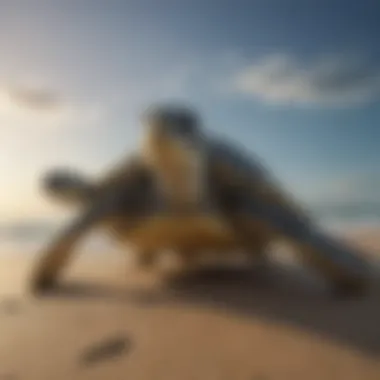Insights into the Enigmatic Green Sea Turtle Population Dynamics


Nature Topic Overview
The green sea turtle, an enchanting marine creature renowned for its majestic presence, serves as a compelling subject of exploration in marine biology and conservation practices. Owing to its distinct features and critical significance in the marine ecosystem, understanding the population dynamics of green sea turtles offers insights into the delicate balance of oceanic biodiversity.
Fun Facts and Trivia
- Contrary to popular belief, green sea turtles are not green - their name is derived from the color of their body fat. However, their shells are typically shades of brown, black, and olive, blending harmoniously with the underwater environment.
- Younglings of green sea turtles instinctively return to the same beach they hatched from, utilizing Earth's magnetic fields as a natural GPS system, a marvel of nature's wondrous precision.
Wildlife Explorations
Green sea turtles are part of an intricate marine ecosystem, coexisting with diverse species such as fish, algae, and coral reefs. Their herbivorous diet plays a crucial role in maintaining the health of seagrass beds, serving as indicators of ecosystem stability and marine health. An interactive exploration of these majestic creatures sheds light on their behavior and interaction with their environment.
Environmental Awareness
Ensuring the conservation and sustainability of green sea turtles is imperative for preserving oceanic biodiversity. Children can contribute to these efforts by raising awareness about marine conservation, reducing plastic waste that threatens marine life, and supporting initiatives that protect sea turtle habitats. Encouraging environmental stewardship in younger generations cultivates a sense of responsibility towards nature and its inhabitants.
DIY Nature Activities
Engaging in eco-friendly activities provides hands-on learning experiences for children. Crafting recycled material sea turtle sculptures, creating seagrass habitat dioramas, or organizing beach clean-up expeditions instill a sense of environmental responsibility and appreciation for the marine world. Encouraging children to partake in outdoor explorations fosters a deeper connection with nature, instilling conservation values from a young age.
Introduction
In this meticulously outlined article, we embark on a fascinating journey into the intricate world of the green sea turtle population. These enigmatic creatures have long captivated the interest of scientists and nature enthusiasts alike. By delving into the nuances of their existence, we aim to unravel the mysteries surrounding their numbers and distribution, shedding light on their importance in the ecosystem.
Overview of Green Sea Turtles
Physical Characteristics
The physical characteristics of the green sea turtle serve as a defining aspect of their species. Their streamlined bodies, designed for aquatic life, boast powerful flippers for swift navigation through ocean waters. The key characteristic of their physical makeup lies in their ability to hold their breath for extended periods, enabling them to undertake long dives in search of food. This remarkable adaptation makes them a resilient choice for our exploration as we uncover the intricacies of their survival strategies.
Habitat Range


Exploring the habitat range of green sea turtles unveils a crucial component of their existence. These marine reptiles exhibit a wide range of habitat preferences, favoring tropical and subtropical waters for nesting and foraging. Their unique feature lies in their migratory patterns, traversing vast distances between feeding and breeding grounds. Understanding the advantages and disadvantages of their habitat range provides valuable insights into the challenges they face and the adaptations that ensure their species' continuity.
Significance of Studying Population
Ecological Role
The ecological role of green sea turtles plays a pivotal part in maintaining the balance of marine ecosystems. As herbivores, they help regulate seagrass beds, promoting biodiversity and influencing nutrient cycling. Their unique feature of seagrass consumption contributes to the resilience of underwater habitats. By examining their ecological role, we unearth the interconnectedness between these creatures and their surrounding environment, highlighting the importance of safeguarding their population.
Conservation Importance
The conservation importance of green sea turtles underscores the urgency of preserving their species. These majestic creatures face numerous threats, from poaching to habitat degradation, putting their population at risk. Understanding the significance of conservation efforts sheds light on the measures required to ensure their survival. By delving into the challenges and successes of conservation initiatives, we gain a deeper appreciation for the fragile balance between human activities and the natural world.
Population Distribution
Population distribution plays a pivotal role in understanding the green sea turtle population dynamics. By analyzing the global distribution and factors influencing it, researchers can make informed decisions regarding conservation strategies and habitat protection.
Global Distribution
Key Regions
Key regions such as the Great Barrier Reef in Australia and the coasts of Costa Rica are essential habitats for green sea turtles. These regions provide ideal nesting sites and rich feeding grounds, contributing significantly to the overall population. The unique feature of these key regions lies in their diverse ecosystems and abundance of seagrass, a vital food source for green sea turtles. Their advantages include suitable temperatures for breeding and adequate protection from predators, making them crucial for maintaining the species.
Migration Patterns
Migration patterns of green sea turtles involve long journeys between feeding and nesting grounds. The key characteristic of these patterns is the seasonal movement from foraging areas to nesting beaches. This behavior is beneficial for population distribution as it ensures genetic diversity and reproductive success. However, it also poses challenges such as threats from fishing activities and habitat degradation along migration routes, impacting the population dynamics.
Factors Influencing Distribution
Understanding the factors influencing green sea turtle distribution is paramount for conservation efforts to be effective.
Temperature Effects
Temperature effects on nesting beaches directly impact hatchling success rates and female turtle populations. Climate change-induced temperature rise presents challenges for egg incubation and could lead to skewed sex ratios among hatchlings. The unique feature of temperature effects is their correlation with rising global temperatures, posing a significant threat to green sea turtle populations. Managing this aspect is crucial for the species' long-term survival.


Food Availability
Food availability in foraging areas affects green sea turtle distribution patterns. Areas with ample seagrass and algae populations attract green sea turtles for feeding. The key characteristic of food availability is its direct link to population health and reproductive success. However, human activities such as overfishing and pollution can deplete food sources, leading to malnutrition among green sea turtles. Protecting these habitats is essential for maintaining a stable population.
Population Size
In this segment of the article, we delve into the crucial aspect of the green sea turtle population size, a fundamental element that provides insights into the overall health and sustainability of these magnificent creatures. Understanding the population size of green sea turtles is paramount as it helps scientists and conservationists gauge the impact of various factors such as environmental changes, human activities, and conservation efforts on their numbers. By studying the population size, researchers can identify trends, assess the effectiveness of conservation programs, and make informed decisions to ensure the long-term viability of green sea turtle populations.
Historical Trends
Past Population Estimates:
Diving deep into the historical trends of green sea turtle populations, examining past population estimates gives us a window into the abundance of these creatures in earlier times. Estimating the population of green sea turtles in the past provides a baseline for comparing current numbers and understanding the changes over time. By analyzing past population estimates, scientists can track population trends, identify factors influencing population dynamics, and develop strategies for conservation and management. The historical perspective afforded by past population estimates is invaluable in guiding conservation efforts and shaping policies to protect these endangered species.
Changes Over Decades:
Exploring the changes in green sea turtle populations over decades offers a nuanced understanding of how external factors have influenced their numbers. Observing population shifts over time reveals the impact of environmental changes, human activities, and conservation interventions on the population dynamics of green sea turtles. By examining the changes over decades, researchers can identify patterns, evaluate the success of conservation measures, and anticipate future challenges. This historical analysis sheds light on the resilience of green sea turtles and the adaptive strategies needed to ensure their survival in the face of changing habitats and increasing threats.
Current Population Status
Monitoring Programs:
Discussing the importance of monitoring programs in assessing the current population status of green sea turtles is vital for conservation efforts. These programs allow scientists to track population trends, monitor nesting activities, and study the behavior of green sea turtles in their natural habitats. By implementing monitoring programs, researchers can gather valuable data on population size, distribution, and demographic trends, aiding in the development of targeted conservation strategies. The insights gained from monitoring programs help in evaluating the effectiveness of conservation measures and making informed decisions to safeguard green sea turtle populations for future generations.
Threats Impacting Numbers:
Examining the threats impacting the numbers of green sea turtles provides a sobering look at the challenges these creatures face in the wild. From habitat loss and pollution to climate change and poaching, green sea turtles confront a myriad of threats that endanger their survival. Understanding the specific threats impacting their numbers is essential in devising conservation plans that address these issues effectively. By identifying and mitigating the threats affecting green sea turtles, conservationists can work towards ensuring a sustainable future for these emblematic marine species.
Population Conservation
Population conservation plays a pivotal role in preserving the delicate balance of the green sea turtle population. By implementing effective conservation strategies, we can safeguard these majestic creatures for future generations to admire and study. Conservation efforts extend beyond mere protection; they encompass a holistic approach to ensure the sustainability of the species. This article delves deep into exploring the various aspects of population conservation, shedding light on the significance of preserving the green sea turtle population.
Conservation Measures


Protective Legislation
Protective legislation forms the cornerstone of population conservation initiatives for the green sea turtle. Laws and regulations aimed at safeguarding habitats and curtailing human-induced threats are essential components of protective legislation. Such regulations provide a legal framework to enforce conservation efforts and hold accountable those who endanger the turtle population. The meticulous implementation of protective legislation is crucial in ensuring the long-term survival of these marine reptiles.
Community Engagement
Community engagement emerges as a powerful tool in bolstering population conservation efforts. By actively involving local communities in conservation projects, a sense of ownership and responsibility is instilled. This fosters a collective commitment towards protecting the habitats of green sea turtles. The synergy between communities, conservationists, and governing bodies can catalyze impactful changes that benefit both the turtles and the ecosystems they inhabit.
Success Stories
Recovery Programs
Recovery programs have been instrumental in reviving dwindling green sea turtle populations. These programs focus on rehabilitating injured or sick turtles, restoring their health, and reintroducing them to their natural habitats. By providing specialized care and support, recovery programs give a second chance to turtles on the brink of extinction. Their success serves as a testament to the efficacy of structured conservation efforts.
Population Growth Achievements
The achievements in green sea turtle population growth signify the positive outcomes of dedicated conservation measures. Through vigilant monitoring and tailored interventions, populations in certain areas have shown promising signs of recovery. The increase in nest numbers and successful hatchings underscore the effectiveness of conservation practices. These achievements underscore the importance of continuing conservation efforts to ensure a thriving future for green sea turtles.
Future Prospects
Challenges Ahead
Climate Change Impacts
A pivotal aspect affecting the green sea turtle population is the looming threat of climate change impacts. These repercussions encompass rising sea temperatures, ocean acidification, and altered marine ecosystems. The key characteristic of climate change impacts is their far-reaching consequences, disrupting the delicate balance that sustains green sea turtle habitats. The unique feature of climate change impacts lies in their indiscriminate nature, affecting not only the turtles directly but also their food sources and nesting grounds. It poses a significant challenge in this context, warranting urgent attention and adaptive strategies to mitigate its adverse effects.
Human Activities
Another critical factor influencing the future prospects of green sea turtles is human activities. The key characteristic of human activities is their diverse forms, ranging from pollution and habitat destruction to poaching and marine debris. Their detrimental impact on green sea turtles is multifaceted, jeopardizing not only individual turtles but entire populations. The unique feature of human activities is their anthropogenic origin, rendering them preventable through concerted conservation actions and sustainable practices. Recognizing and addressing the repercussions of human interventions is essential to safeguarding the long-term viability of green sea turtle populations.
Research Directions
Technological Innovations
Within the realm of researching green sea turtle populations, technological innovations play a crucial role in enhancing data collection, monitoring, and conservation strategies. The key characteristic of technological innovations is their ability to provide real-time insights into turtle behavior, habitat usage, and migration patterns. Their relevance to this article lies in revolutionizing conservation efforts through advanced tracking devices, remote sensing technologies, and genetic analyses. The unique feature of technological innovations is their capacity to bridge the gap between scientific research and practical conservation applications, facilitating evidence-based decision-making for the protection of green sea turtles.
Population Modeling
Another key avenue for exploring green sea turtle populations is through population modeling, offering valuable insights into population dynamics, trends, and projections. The key characteristic of population modeling is its predictive power, allowing researchers to assess the impact of various factors on population viability. Its contribution to this article lies in informing conservation strategies, adaptive management practices, and policy formulation based on robust data-driven models. The unique feature of population modeling is its capacity to simulate different scenarios, aiding in the identification of optimal interventions for enhancing the resilience of green sea turtle populations.







